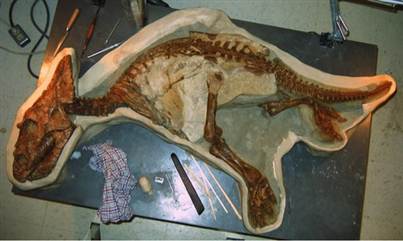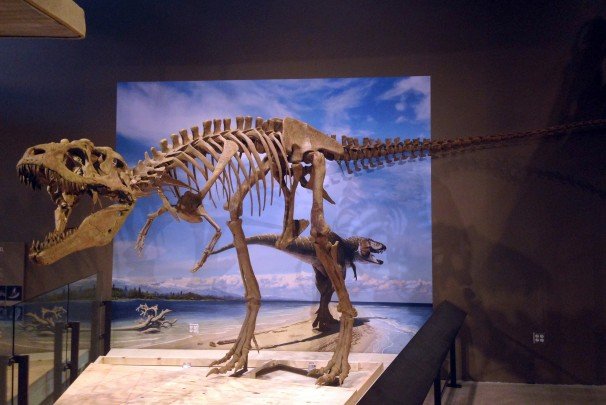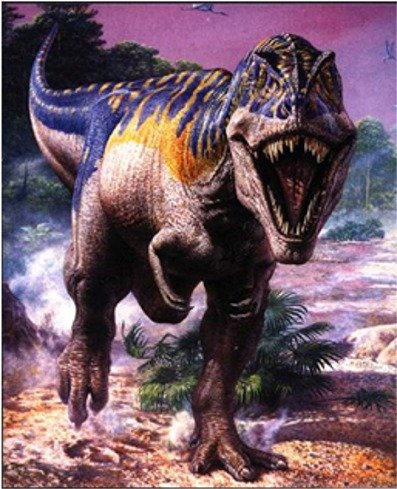An intact skeleton of a baby rhinoceros like dinosaur has been unearthed in Canada.
The baby dinosaur was just 3 years old and 5 feet long when it wandered into a river near Alberta and drowned about 70 million years ago. The beast was so well-preserved that some of its skin left impressions in the nearby rock.
The fossil is the smallest intact skeleton ever found from a group of horned, plant-eating dinosaurs known as ceratopsids, a group that includes the iconic Triceratops.
Finding intact baby dinosaurs is incredibly rare.
“The big ones just preserve better: They don’t get eaten, they don’t get destroyed by animals,” said study co-author Philip Currie, a paleobiologist at the University of Alberta. “You always hope you’re going to find something small and that it will turn out to be a dinosaur.”
Paleontologists had unearthed a few individual bones from smaller ceratopsids in the past. But without intact juvenile skeletons, such bones aren’t very useful, as scientists don’t really know how each bone changes during each stage of the animals’ lives, Philip Currie said.
The team was bone-hunting in Dinosaur Provincial Park in Alberta when Currie came upon what looked like a turtle shell sticking out from a hillside. Upon closer inspection, the fossil turned out to be a frill, the bony decorative headgear that surrounds the back of the head in ceratopsids.

The baby dinosaur was just 3 years old and 5 feet long when it wandered into a river near Alberta and drowned about 70 million years ago
When the team excavated, they found the fossilized skeleton of a tiny dinosaur they identified as a Chasmosaurus belli, a species commonly found in the area.
Amazingly, almost the entire skeleton was intact, although sometime in the past, a sinkhole had opened up below the beast and the forelimbs had fallen away into an abyss. The fossil was so well-preserved that the tiny, rosette like pattern on its skin was imprinted in the rock below the dinosaur.
Based on its size, the team estimates the dinosaur was about 3 years old – just out of infancy – when it perished.
Like humans, these dinosaurs typically take about 20 years to reach maturity, at which point they have 6.5-foot-long skulls and weigh 3 to 4 tons.
The fossil was found in sediments associated with watery environments and didn’t have any bite marks or trace of injury, so it’s likely the dino toddler likely drowned.
“I think it may have just gotten trapped out of its league in terms of water current,” Philip Currie told LiveScience.
Soon after, the baby dinosaur was buried by sediments and left untouched for millions of years.
Aside from being cute, the new fossil helps paleontologists understand how these plant-eating dinosaurs grew. Paleontologists can then better identify and age the myriad individual bones from juveniles discovered over the years.
Already, the team has learned that Chasmosaur juvenile frills look different from those on adults, and that limb proportions don’t change much as they grow. Predatory theropods such as Tyrannosaurus rex have disproportionately long limbs as juveniles, presumably to keep up with the adults in the pack.
By contrast, “in Chasmosaurians, the proportions are essentially the same, which probably means the adults were probably never moving that fast,” Philip Currie said.
“There was never priority for these animals to run to keep up with the adults.”
A relative of the Tyrannosaurus rex has been unearthed in southern Utah, marking the discovery of the oldest known member of its group of dinosaurs yet.
The newly discovered dinosaur measured about 24 feet long, weighed around 2.5 metric tons, and had a large head filled with sharp teeth. To evoke just what a powerful predator it was, researchers have given it a fittingly grand name: Lythronax argestes, which translates to gore king of the Southwest.

The newly discovered dinosaur measured about 24 feet long, weighed around 2.5 metric tons, and had a large head filled with sharp teeth
The discovery is being reported this week in PLOS One by researchers led from the Natural History Museum of Utah. They describe the Lythronax as a two-legged carnivore with a short, narrow snout that lived around 80 million years ago. With the back of the Lythronax’s skull being on the wider side as well, the researchers note that it actually resembles the T. rex – which lived 10 to 12 million year later – more than any other dinosaur that lived alongside it.
“Lythronax may demonstrate that tyrannosaurs followed a pattern similar to what we see in other dinosaurs from this age, with different species living in the north and south at the same time,” Joseph Sertich, a co-author of the report, says in a statement.
Lythronax lived on the ancient continent of Laramidia, a split-off portion of North America that ran from Alaska, down the west coast of the US, and into Mexico. The researchers suggest that the sea that divided North America may also have spilled over into Laramidia, at times dividing its north and south and allowing dinosaur genera to divide into a variety of species. As for the recovered Lythronax fossils, the researchers will be keeping them close to home – they’ll be on display at the Natural History Museum of Utah in Salt Lake City as part of its permanent collection.
[youtube JXZSq17AMlY 650]

Jack Horner, the technical adviser on Jurassic Park and professor of palaeontology at Montana State University, is hoping to use living birds to hatch a dinosaur
Jack Horner, the technical adviser on Jurassic Park and professor of palaeontology at Montana State University, is hoping to use living birds to hatch a dinosaur.
Jack Horner believes that a modern bird’s DNA contains a genetic memory that could be “switched on” again, resurrecting long-dormant dinosaur traits.
What’s more, Jack Horner is looking for a helper to assist in the retro-engineering of a prehistoric beast.
Jack Horner told LiveScience: “I’m looking for a postdoctoral researcher. An adventurous postdoc who knows a lot about developmental biology and a little bit about birds.”
He explains that to make a dinosaur, he would start with the genome (the whole hereditary information encoded in the DNA) of an emu.
“Emus have all the features we need in order to make a Velociraptor-sized dinosaur,” Jack Horner says.
“If I were to make a dinosaur that is where I’d start.”
Jack Horner’s work is supported by other leading academics.
Sean Carroll, a geneticist at the University of Wisconsin, says: “The inventory of genes in a bird would be very similar to the inventory of genes in a dinosaur.
“It is differences in the decision-making that takes during development that make the difference between a chicken and a tyrannosaurus.”
Hans Larsson, a palaeontologist at McGill University in Canada, conducted an experiment recently into the evolution from dinosaurs’ long tails into birds’ short tails more than 150 million years ago.
Looking at a two-day-old chicken embryo, he made an unexpected discovery.
Expecting to see between four and eight vertebrae present in the developing spine, his microscope instead picked out 16 vertebrae – effectively a reptilian tail.
As the embryo developed, the “tail” became shorter and shorter, until the young bird hatched with only five vertebrae.
Hans Larsson says of the significance of the find: “For about 150 million years, this kind of a tail has never existed in birds.
“But they have always carried it deep inside their embryology.”
So, the blueprint for a dinosaur remained locked inside the modern-day bird.
Hans Larsson now believes that in a hundred years or so, geneticists could retro-engineer animals that appear identical to Mesozoic dinosaurs.
“Why can’t we take all the genetics, just change it around a little bit, and produce a Tyrannosaurus Rex, or something that looks like one?” he asks.
“I think that kind of scenario is quite possible. Maybe sooner than we think.”
John Fallon, a developmental biologist at the University of Wisconsin, agrees, saying: “As we learn more, we’ll be able to do it.
“The genetic knowledge is in the bird.”
Jack Horner, meanwhile, imagines creating the first example.
“I have to admit that I’ve certainly imagined walking up on a stage to give a talk, and having a little dino-chicken walk up behind me,” he says.
“That would be kind of cool.
“There is now nothing to stop us bringing back dinosaurs but ourselves.
“People who don’t believe it don’t know much about evolution.”
Jack Horner adds: “Whether it is a good idea or not is another question…”



